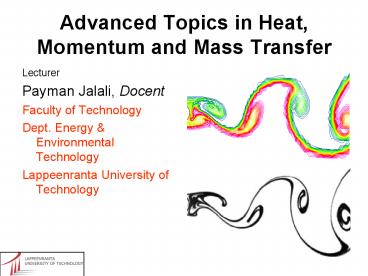Advanced Topics in Heat, Momentum and Mass Transfer - PowerPoint PPT Presentation
1 / 29
Title:
Advanced Topics in Heat, Momentum and Mass Transfer
Description:
Problem 1: Solve a conduction problem using FLUENT. ... see that there is only energy equation which is ... We create a 'custom field function' calculating: ... – PowerPoint PPT presentation
Number of Views:104
Avg rating:3.0/5.0
Title: Advanced Topics in Heat, Momentum and Mass Transfer
1
Advanced Topics in Heat, Momentum and Mass
Transfer
- Lecturer
- Payman Jalali, Docent
- Faculty of Technology
- Dept. Energy Environmental Technology
- Lappeenranta University of Technology
2
Problem 1 Solve a conduction problem using
FLUENT. In the given geometry below, define the
solution domain as a solid and solve the
conduction equation with specified boundary
conditions.
3
Create edges
4
Create grids, option 1 Uniform grid
5
Create grids, option 2 Nonuniform grid
6
Define all the boundaries as wall
7
Define the domain as SOLID Then File ? Export
? Mesh and save the export file for using in
FLUENT.
8
Open 2d FLUENT and read the mesh file. File ?
Read ? Case Grid ? Check Here, we do not need to
scale the dimensions. So, we skip Grid ?
Scale Grid ? Smooth/Swap Turn on the Energy
equation Define ? Models ? Energy Define ?
Material
9
Disply ? Grid
10
Set Boundary conditions For the solid domain,
check the type is solid then click on it and
choose the material, add the source term (G0) in
W/m3, if exists.
In the first case, we turn off the source term
and in the second case it is set to 500 W/m3.
11
Set Boundary conditions For the boundaries with
the type wall we do not see an active
Momentum boundary condition as they are all
next to a solid domain. There is only Thermal
section active.
12
Set Boundary conditions For the boundaries with
given temperature, we have
13
Iterate after initialization. You will see that
there is only energy equation which is solved (as
there is no flow in the solid domain!).
14
Display ? Contours
15
(No Transcript)
16
We change the boundary condition on the upper
boundary to convective boundary condition
17
(No Transcript)
18
(No Transcript)
19
In order to make sure about the validity and the
accuracy of results, we can check the overall
balance of thermal energy in the system just by
noting that Volumetric heat generation Overall
surface heat exchange Report ? Fluxes We know
that the volumetric heat is G0V5001500 W
So there is some error about 10/5002, which can
be due to the size of mesh, discretization etc.
20
Problem 2 Determine boundary conditions for the
previous conduction problem for a case in which
convection of fluid exists.
We read the previous msh file in FLUENT and just
change the boundary conditions.
The boundary conditions the inlet and outlet are
selected as follows - The velocity-inlet for
inlet and pressure-outlet for outlet
21
Note that in the beginning we do not turn on the
energy equation. All boundary conditions are set
for momentum.
22
We check the inlet and outlet mass flow rates
23
Display ? Vectors The outlet flow is as shown by
the velocity vectors in this figure. Since the
outlet velocity has component in y direction, the
velocity magnitude is larger. We can also check
the energy equation (Bernoulli equation). We
create a custom field function calculating
Since there is no effect of gravity, it doesnt
appear in Bernoullis equation. This function is
constant if we have inviscid flow with no
mechanical work. However, it should decrease from
inlet to outlet because of the work on fluid and
viscous losses.
24
Define ? Custom Field Functions We can define the
custom field function through its corresponding
window
25
Then we can compare its values in inlet and
outlet
Inlet
Outlet
The difference is the total mechanical work (on
fluid) and viscous loss 1.886535-1.2074970.67
90 m2/s2 This is equivalent to 0.6790/9.810.0692
m H2O
26
By far, we have obtained the solution of
Navier-Stokes equations which gives us pressure,
and velocity components. The energy equation is a
scalar equation which can be solved using the
velocity field. However, the above-mentioned
example has a very high convective feature as the
inlet velocity is 1 m/s. We decrease the inlet
velocity substantially to 0.0001 m/s which is a
slow laminar flow. After a similar procedure for
solving the problem we get the following results.
27
Now, turn on Energy Equation. Set the thermal
boundary conditions.
Other boundaries are set to q0 by default.
28
We continue iterations with the energy equation,
which converges quite quickly.
29
We can check the heat balance over the surfaces.
The overall heat transfer rate is almost 0. So,
they are in balance.































